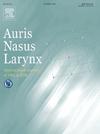利用光子计数检测器CT改善颞骨结构的可视化:一项患者内比较
IF 1.5
4区 医学
Q2 OTORHINOLARYNGOLOGY
引用次数: 0
摘要
目的直接比较光子计数检测器CT (PCD-CT)与常规能量积分检测器CT (EID-CT)在同一患者队列中颞骨成像的图像质量。方法回顾性研究7例同时行EID-CT和PCD-CT检查临床指征的患者。为了确保成像技术的有效比较,我们对未手术的对侧颞骨图像进行了评估。记录辐射剂量参数,包括体积CT剂量指数(CTDIvol)和剂量长度积(DLP)。两名专业耳鼻喉科医师使用5分制李克特量表对6个关键解剖结构(包括镫骨关节、包括踝关节、卵圆窗、圆窗、小尺骨和胸骨)的可视化程度进行独立评分。结果pd - ct对所有6个评估结构的显示均有显著优势(p < 0.05)。与EID-CT相比,PCD-CT的平均李克特评分从3.7到5.0不等,表明图像质量一直被评为“轻度优越”到“相当优越”。两种方案的辐射剂量(CTDIvol和DLP)无显著差异。结论在直接的患者内部比较中,PCD-CT在与传统EID-CT相当的辐射剂量下提供了更好的图像质量和颞骨精细解剖结构的可视化。这项技术代表了耳科成像的重大进步。本文章由计算机程序翻译,如有差异,请以英文原文为准。
Improved visualization of temporal bone structures with photon-counting detector CT: An intra-patient comparison
Objective
To directly compare the image quality of photon-counting detector CT (PCD-CT) and conventional energy-integrating detector CT (EID-CT) for temporal bone imaging within the same patient cohort.
Methods
This retrospective study included seven patients who underwent both EID-CT and PCD-CT for clinical indications. To ensure a valid comparison of the imaging technologies, images of the non-operated, contralateral temporal bone were evaluated. Radiation dose parameters, including volume CT dose index (CTDIvol) and dose-length product (DLP), were recorded. Two board-certified otolaryngologists independently rated the visualization of six key anatomical structures (incudostapedial joint, incudomalleolar joint, oval window, round window, modiolus, and scutum) using a 5-point Likert scale.
Results
PCD-CT demonstrated significantly superior visualization for all six evaluated structures according to both readers (p < 0.05 for all). The average Likert scores for PCD-CT compared to EID-CT ranged from 3.7 to 5.0, indicating that image quality was consistently rated as "mildly superior" to "substantially superior." There was no significant difference in radiation dose (CTDIvol and DLP) between the two protocols.
Conclusion
In a direct intra-patient comparison, PCD-CT provides superior image quality and visualization of fine anatomical structures of the temporal bone at a radiation dose comparable to conventional EID-CT. This technology represents a significant advancement for otologic imaging.
求助全文
通过发布文献求助,成功后即可免费获取论文全文。
去求助
来源期刊

Auris Nasus Larynx
医学-耳鼻喉科学
CiteScore
3.40
自引率
5.90%
发文量
169
审稿时长
30 days
期刊介绍:
The international journal Auris Nasus Larynx provides the opportunity for rapid, carefully reviewed publications concerning the fundamental and clinical aspects of otorhinolaryngology and related fields. This includes otology, neurotology, bronchoesophagology, laryngology, rhinology, allergology, head and neck medicine and oncologic surgery, maxillofacial and plastic surgery, audiology, speech science.
Original papers, short communications and original case reports can be submitted. Reviews on recent developments are invited regularly and Letters to the Editor commenting on papers or any aspect of Auris Nasus Larynx are welcomed.
Founded in 1973 and previously published by the Society for Promotion of International Otorhinolaryngology, the journal is now the official English-language journal of the Oto-Rhino-Laryngological Society of Japan, Inc. The aim of its new international Editorial Board is to make Auris Nasus Larynx an international forum for high quality research and clinical sciences.
 求助内容:
求助内容: 应助结果提醒方式:
应助结果提醒方式:


